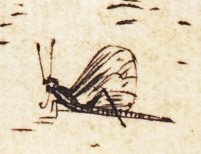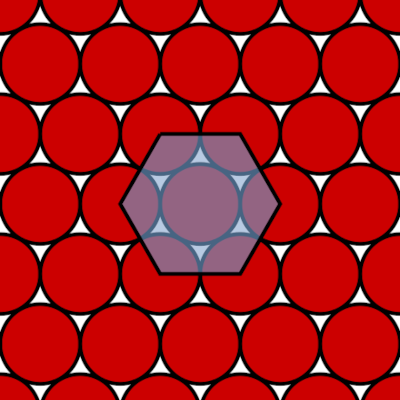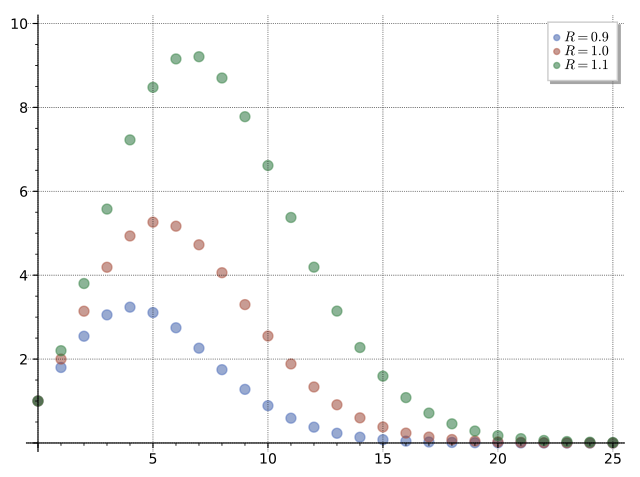“Foreign nations are a contemporaneous posterity.”
— “A forgotten American essayist,” quoted by Brander Matthews in his introduction to The Oxford Book of American Essays, 1914
“Foreign nations are a contemporaneous posterity.”
— “A forgotten American essayist,” quoted by Brander Matthews in his introduction to The Oxford Book of American Essays, 1914

A puzzle by Lee Sallows. In this readout from a computer-driven electronic display, the digits in the fifth row have been obscured. What are they?
https://www.youtube.com/watch?v=9udNrOh5DyA
res angusta domi
n. straitened financial circumstances
appaumé
adj. having the hand opened out so as to display the palm
mammering
n. a state of hesitation or doubt
manuduction
n. careful guidance
dactylonomy
n. the art of counting on the fingers
belve
v. to roar or bellow

Soliloquy of a mayfly, imagined by Benjamin Franklin in a 1778 letter to Madame Brillon:
It was the opinion of learned philosophers of our race, who lived and flourished long before my time, that this vast world, the Moulin Joly, could not itself subsist more than eighteen hours; and I think there was some foundation for that opinion, since, by the apparent motion of the great luminary that gives life to all nature, and which in my time has evidently declined considerably towards the ocean at the end of our earth, it must then finish its course, be extinguished in the waters that surround us, and leave the world in cold and darkness, necessarily producing universal death and destruction. I have lived seven of those hours, a great age, being no less than four hundred and twenty minutes of time. How very few of us continue so long! I have seen generations born, flourish, and expire. My present friends are the children and grandchildren of the friends of my youth, who are now, alas, no more! And I must soon follow them; for, by the course of nature, though still in health, I cannot expect to live above seven or eight minutes longer. What now avails all my toil and labor in amassing honey-dew on this leaf, which I cannot live to enjoy! What the political struggles I have been engaged in for the good of my compatriot inhabitants of this bush, or my philosophical studies for the benefit of our race in general! for in politics what can laws do without morals? Our present race of ephemeræ will in a course of minutes become corrupt, like those of other and older bushes, and consequently as wretched. And in philosophy how small our progress! Alas! art is long, and life is short! My friends would comfort me with the idea of a name they say I shall leave behind me; and they tell me I have lived long enough to nature and to glory. But what will fame be to an ephemera who no longer exists? And what will become of all history in the eighteenth hour, when the world itself, even the whole Moulin Joly, shall come to its end and be buried in universal ruin?
Franklin added, “To me, after all my eager pursuits, no solid pleasures now remain, but the reflection of a long life spent in meaning well, the sensible conversation of a few good lady ephemeræ, and now and then a kind smile and a tune from the ever amiable Brillante.”

Can any 10 points on a plane always be covered with some number of nonoverlapping unit discs?
It’s not immediately clear that the answer is yes. The most efficient way to pack circles together on the plane is the hexagonal packing shown above; it covers about 90.69 percent of the surface. But if our 10 points are inconveniently arranged, it’s not clear that we’ll always be able to shift the array of circles around in order to get them all covered.
In this case there’s a neat proof that takes advantage of a technique called the probabilistic method — if, for a group of objects, the probability is less than 1 that a randomly chosen object does not have a certain property, then there must exist an object that has this property.
Take a hexagonal packing randomly. Then, for any point on the plane, the probability that it’s not covered by the chosen packing is about 1 – 0.9069 = 0.0931. This means that for any 10 points, the chance that one or more points are not covered is approximately 0.0931 × 10 = 0.931. And that’s less than 1.
“Therefore, we obtain from the principle that there exists some closest packing that covers all the 10 points,” writes mathematician Hirokazu Iwasawa of the Institute of Actuaries of Japan. “And, in such a packing, we actually need at most 10 discs to cover the 10 points.”
(Hirokazu Iwasawa, “Using Probability to Prove Existence,” Mathematical Intelligencer 34:3 [September 2012], 11-14. The puzzle was created by Naoki Inaba.)
At Princeton in the 1940s, Albert Einstein became a close friend of logician Kurt Gödel, whose incompleteness theorems lie at the heart of modern mathematics. Toward the end of his life Einstein said that his “own work no longer meant much, that he came to the Institute merely … to have the privilege of walking home with Gödel.”
In 1947 Einstein and economist Oskar Morgenstern accompanied Gödel to his U.S. citizenship exam because they were concerned about his unpredictable behavior: During his voluminous preparation for the exam, Gödel said, he had uncovered a flaw in the U.S. constitution that could lead to a dictatorship. Einstein and Morgenstern told him that the exam would really be quite simple and urged him not to prepare so extensively.
At the hearing, judge Phillip Forman asked Gödel:
“Now, Mr. Gödel, where do you come from?”
“Where I come from? Austria.”
“What kind of government did you have in Austria?”
“It was a republic, but the constitution was such that it finally was changed into a dictatorship.”
“Oh! That is very bad. This could not happen in this country.”
“Oh, yes,” Gödel said. “I can prove it.”
“So of all the possible questions, just that critical one was asked by the Examinor,” Morgenstern wrote later. “Einstein and I were horrified during this exchange; the Examinor was intelligent enough to quickly quieten Gödel and say, ‘Oh, God, let’s not go into this.'”
The logician got his citizenship and the friends returned to Princeton. What was the flaw that Gödel had found? There’s no record of it in Morgenstern’s account, so we don’t know. Stephen Hawking suggests that it involved the president’s power to fill vacancies during Senate recesses, and Barry University law professor F.E. Guerra-Pujol conjectures that it might involve the constitution’s power to amend itself. Maybe it’s best if we never discover it.
(Thanks, Louis.)
I found this surprising. What’s the volume of a ball of radius 1 in various dimensions?
In one dimension it’s a line segment of length 2.
In two dimensions it’s a unit disc in the plane, with area π.
In three dimensions it’s a unit ball with volume 4π/3.
Intuitively we might expect the number to keep rising. But it doesn’t!

In fact it peaks at five dimensions, and it drops quite sharply after that. In 20 dimensions the volume is only 0.026, and the limiting value is zero. Wikipedia explains the math.

Natural philosopher John Wilkins’ Mathematical Magick of 1648 contains a startling passage in which he foretells the advantages of a long-range submarine, or “ship, wherein men may safely swim underwater”:
Wilkins was aware of Cornelius Drebbel’s primitive sub of 1620, but he looks much farther ahead, seeming to foresee combat submarines and deep-sea exploration vessels.
“I am not able to judge what other advantages there may be suggested, or whether experiment would fully answer to these notional conjectures,” he concluded. “But however, because the invention did unto me seem ingenious and new, being not impertinent to the present enquiry, therefore I thought it might be worth the mentioning.”
(From Joseph J. Thorndike Jr., ed., Mysteries of the Deep, 1980.)

A curious physics puzzle from Mark Levi’s excellent Why Cats Land on Their Feet: Suppose two astronauts, Al and Bob, are strapped to opposite ends of a space capsule’s interior, Al on the left and Bob on the right. Al is holding a large helium balloon, and everything is at rest. If Al pushes the balloon toward Bob, which way will the capsule drift?
It would be reasonable to guess that the capsule will drift to the left. Newton’s third law says that action equals reaction, so as Al pushes the balloon to the right, the balloon pushes Al to the left, and since he’s strapped to the capsule, he and it should drift left.
In fact the capsule will drift right as well. Because there are no external forces, the center of mass of the whole system is fixed. The helium balloon has less mass than the air it displaces, so from Al’s point of view the center of mass moves left. But the center of mass of the whole system is fixed in space, so the capsule must move right from the point of view of an external observer.
One way to make this intuitive is to imagine that the capsule is full of water rather than air. The mass of water essentially stays in place while we transfer a bubble of helium from the water’s left to its right. To accommodate this, the shell (whose mass we neglect) must move to the right.

Japanese pilot Kaname Harada recalls air combat in World War II:
The initial feeling after shooting down someone was relief, because it was not me who was shot down. My next thought was that I was a better pilot, so I felt superior to the enemy aviator who was shot down. These feelings lasted only for a short time. When we shot at each other, we were at very close range, and during this time I could see my opponent’s face very well. When I saw the enemy’s face, it looked terrible because he was going down. Soon after this I felt very bad, because I could imagine that my opponent had a family of his own, and I killed him. Therefore, to this day I feel very bad about shooting down pilots during the war.
Afterward, when these faces haunted his dreams, Harada became an antiwar activist and even traveled to the United States and Britain to meet some of the pilots he’d fought against. “In general, I have a bad feeling about being involved in the war, and I feel guilty about killing other people in combat,” he said. “I also feel that the war should not have happened in the first place. This is because the governments of countries around the world don’t make an effort to resolve their differences. Instead, they order their armed forces to kill each other. I believe World War II veterans know this best, because we were used as ‘pawns’ by our government to fight a war.”
(From Ron Werneth, Beyond Pearl Harbor, 2008.)